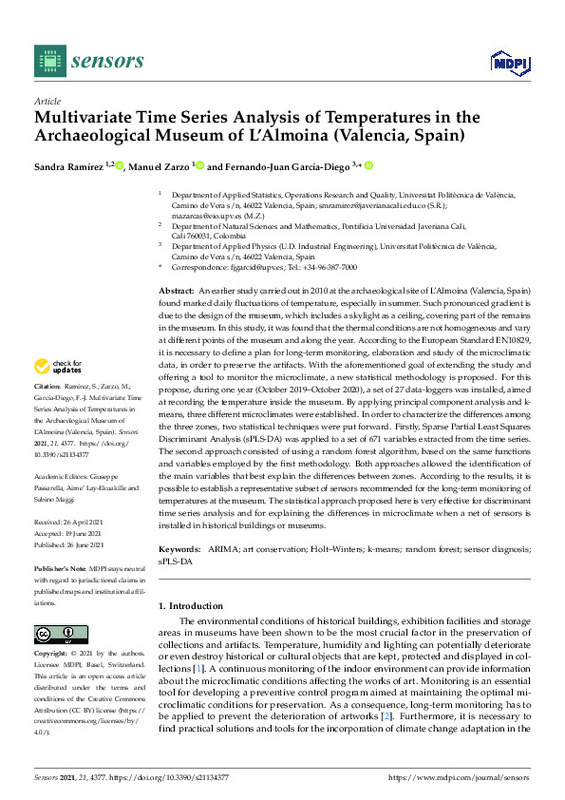JavaScript is disabled for your browser. Some features of this site may not work without it.
Buscar en RiuNet
Listar
Mi cuenta
Estadísticas
Ayuda RiuNet
Admin. UPV
Multivariate time series analysis of temperatures in the archaeological museum of L'Almoina (Valencia, Spain)
Mostrar el registro sencillo del ítem
Ficheros en el ítem
| dc.contributor.author | Ramírez, Sandra
|
es_ES |
| dc.contributor.author | Zarzo Castelló, Manuel
|
es_ES |
| dc.contributor.author | García Diego, Fernando Juan
|
es_ES |
| dc.date.accessioned | 2022-05-02T18:05:15Z | |
| dc.date.available | 2022-05-02T18:05:15Z | |
| dc.date.issued | 2021-07 | es_ES |
| dc.identifier.uri | http://hdl.handle.net/10251/182359 | |
| dc.description.abstract | [EN] An earlier study carried out in 2010 at the archaeological site of L'Almoina (Valencia, Spain) found marked daily fluctuations of temperature, especially in summer. Such pronounced gradient is due to the design of the museum, which includes a skylight as a ceiling, covering part of the remains in the museum. In this study, it was found that the thermal conditions are not homogeneous and vary at different points of the museum and along the year. According to the European Standard EN10829, it is necessary to define a plan for long-term monitoring, elaboration and study of the microclimatic data, in order to preserve the artifacts. With the aforementioned goal of extending the study and offering a tool to monitor the microclimate, a new statistical methodology is proposed. For this propose, during one year (October 2019-October 2020), a set of 27 data-loggers was installed, aimed at recording the temperature inside the museum. By applying principal component analysis and k-means, three different microclimates were established. In order to characterize the differences among the three zones, two statistical techniques were put forward. Firstly, Sparse Partial Least Squares Discriminant Analysis (sPLS-DA) was applied to a set of 671 variables extracted from the time series. The second approach consisted of using a random forest algorithm, based on the same functions and variables employed by the first methodology. Both approaches allowed the identification of the main variables that best explain the differences between zones. According to the results, it is possible to establish a representative subset of sensors recommended for the long-term monitoring of temperatures at the museum. The statistical approach proposed here is very effective for discriminant time series analysis and for explaining the differences in microclimate when a net of sensors is installed in historical buildings or museums. | es_ES |
| dc.description.sponsorship | The authors are grateful to Angel Perles for his support in this research. In addition, the authors would like to thank the Museum of L'Almoina, managed by the local government of Valencia (Spain) and his director Vicent Escriva. Thanks are also given to Esther Nebot Diaz from the "Department of Conservation and Restoration of Cultural Heritage" of the Polytechnic University of Valencia (UPV) for her help in the calibration of sensors. S.R. wants to thank the grant received from Instituto Colombiano de Credito Educativo y Estudios Tecnicos en el Exterior (ICETEX) by means of Programa credito Pasaporte a la Ciencia ID 3595089, as well as by Pontificia Universidad Javeriana Cali (Nit 860013720-1) through the Convenio de Capacitacion para Docentes O. J. 086/17. | es_ES |
| dc.language | Inglés | es_ES |
| dc.publisher | MDPI AG | es_ES |
| dc.relation.ispartof | Sensors | es_ES |
| dc.rights | Reconocimiento (by) | es_ES |
| dc.subject | ARIMA | es_ES |
| dc.subject | Art conservation | es_ES |
| dc.subject | Holt-Winters | es_ES |
| dc.subject | K-means | es_ES |
| dc.subject | Random forest | es_ES |
| dc.subject | Sensor diagnosis | es_ES |
| dc.subject | SPLS-DA | es_ES |
| dc.subject.classification | FISICA APLICADA | es_ES |
| dc.subject.classification | ESTADISTICA E INVESTIGACION OPERATIVA | es_ES |
| dc.title | Multivariate time series analysis of temperatures in the archaeological museum of L'Almoina (Valencia, Spain) | es_ES |
| dc.type | Artículo | es_ES |
| dc.identifier.doi | 10.3390/s21134377 | es_ES |
| dc.relation.projectID | info:eu-repo/grantAgreement/EC/H2020/814624/EU | es_ES |
| dc.relation.projectID | info:eu-repo/grantAgreement/ICETEX//3595089/ | es_ES |
| dc.relation.projectID | info:eu-repo/grantAgreement/Pontificia Universidad Javeriana//O. J. 086%2F17//Convenio de Capacitación para Docentes/ | es_ES |
| dc.rights.accessRights | Abierto | es_ES |
| dc.contributor.affiliation | Universitat Politècnica de València. Departamento de Física Aplicada - Departament de Física Aplicada | es_ES |
| dc.contributor.affiliation | Universitat Politècnica de València. Departamento de Estadística e Investigación Operativa Aplicadas y Calidad - Departament d'Estadística i Investigació Operativa Aplicades i Qualitat | es_ES |
| dc.description.bibliographicCitation | Ramírez, S.; Zarzo Castelló, M.; García Diego, FJ. (2021). Multivariate time series analysis of temperatures in the archaeological museum of L'Almoina (Valencia, Spain). Sensors. 21(13):1-40. https://doi.org/10.3390/s21134377 | es_ES |
| dc.description.accrualMethod | S | es_ES |
| dc.relation.publisherversion | https://doi.org/10.3390/s21134377 | es_ES |
| dc.description.upvformatpinicio | 1 | es_ES |
| dc.description.upvformatpfin | 40 | es_ES |
| dc.type.version | info:eu-repo/semantics/publishedVersion | es_ES |
| dc.description.volume | 21 | es_ES |
| dc.description.issue | 13 | es_ES |
| dc.identifier.eissn | 1424-8220 | es_ES |
| dc.identifier.pmid | 34206737 | es_ES |
| dc.identifier.pmcid | PMC8271729 | es_ES |
| dc.relation.pasarela | S\440848 | es_ES |
| dc.contributor.funder | Pontificia Universidad Javeriana | es_ES |
| dc.contributor.funder | COMISION DE LAS COMUNIDADES EUROPEA | es_ES |
| dc.contributor.funder | Instituto Colombiano de Crédito Educativo y Estudios Técnicos en el Exterior | es_ES |
| upv.costeAPC | 2178 | es_ES |








